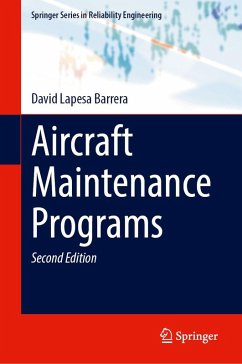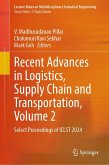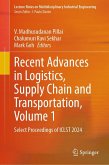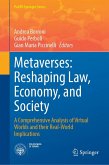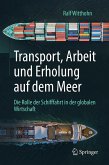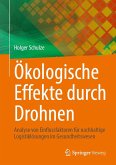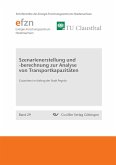David Lapesa Barrera
Aircraft Maintenance Programs
David Lapesa Barrera
Aircraft Maintenance Programs
- Gebundenes Buch
- Merkliste
- Auf die Merkliste
- Bewerten Bewerten
- Teilen
- Produkt teilen
- Produkterinnerung
- Produkterinnerung
This book, now in an updated and expanded second edition, provides the only comprehensive comparison of the Aircraft Maintenance Program (AMP) requirements of the world s leading aviation regulators today: the European Aviation Safety Agency (EASA) and the Federal Aviation Administration (FAA). It offers an in-depth examination of the elements of an AMP, explaining the aircraft accident investigations and events that have shaped and informed the current rules.
By introducing the Triangle of Airworthiness model (Reliability, Quality, and Safety), this book enables easier understanding of the…mehr
Andere Kunden interessierten sich auch für
![Recent Advances in Logistics, Supply Chain and Transportation, Volume 2 Recent Advances in Logistics, Supply Chain and Transportation, Volume 2]() Recent Advances in Logistics, Supply Chain and Transportation, Volume 2211,99 €
Recent Advances in Logistics, Supply Chain and Transportation, Volume 2211,99 €![Recent Advances in Logistics, Supply Chain and Transportation, Volume 1 Recent Advances in Logistics, Supply Chain and Transportation, Volume 1]() Recent Advances in Logistics, Supply Chain and Transportation, Volume 1208,99 €
Recent Advances in Logistics, Supply Chain and Transportation, Volume 1208,99 €![Metaverses: Reshaping Law, Economy, and Society Metaverses: Reshaping Law, Economy, and Society]() Metaverses: Reshaping Law, Economy, and Society136,99 €
Metaverses: Reshaping Law, Economy, and Society136,99 €![Transport, Arbeit und Erholung auf dem Meer Transport, Arbeit und Erholung auf dem Meer]() Ralf WitthohnTransport, Arbeit und Erholung auf dem Meer39,99 €
Ralf WitthohnTransport, Arbeit und Erholung auf dem Meer39,99 €![Ökologische Effekte durch Drohnen Ökologische Effekte durch Drohnen]() Holger SchulzeÖkologische Effekte durch Drohnen109,99 €
Holger SchulzeÖkologische Effekte durch Drohnen109,99 €![Szenarienerstellung und -berechnung zur Analyse von Transportkapazitäten. Gutachten im Auftrag der Stadt Pegnitz Szenarienerstellung und -berechnung zur Analyse von Transportkapazitäten. Gutachten im Auftrag der Stadt Pegnitz]() Szenarienerstellung und -berechnung zur Analyse von Transportkapazitäten. Gutachten im Auftrag der Stadt Pegnitz19,80 €
Szenarienerstellung und -berechnung zur Analyse von Transportkapazitäten. Gutachten im Auftrag der Stadt Pegnitz19,80 €![Prototyp zur Lagerverwaltung in Python Prototyp zur Lagerverwaltung in Python]() Sven WirsingPrototyp zur Lagerverwaltung in Python49,99 €
Sven WirsingPrototyp zur Lagerverwaltung in Python49,99 €-
-
-
This book, now in an updated and expanded second edition, provides the only comprehensive comparison of the Aircraft Maintenance Program (AMP) requirements of the world s leading aviation regulators today: the European Aviation Safety Agency (EASA) and the Federal Aviation Administration (FAA). It offers an in-depth examination of the elements of an AMP, explaining the aircraft accident investigations and events that have shaped and informed the current rules.
By introducing the Triangle of Airworthiness model (Reliability, Quality, and Safety), this book enables easier understanding of the processes by which an aircraft and its components are deemed to be in a safe condition for operation, from a cost-effective and optimization perspective. It compares the best practices used by top airlines and compiles a series of tools and techniques to improve AMP standards.
This book s updated coverage introduces key enhancements, including updates to the MSG-3 methodologywith Aircraft Health Monitoring, an explanation of the forthcoming MSG-4 standard with Condition-Based Maintenance concepts, the inclusion of Aircraft Cyber Security for Continuing Airworthiness, and a review of emerging technologies in the Innovation chapter.
By introducing the Triangle of Airworthiness model (Reliability, Quality, and Safety), this book enables easier understanding of the processes by which an aircraft and its components are deemed to be in a safe condition for operation, from a cost-effective and optimization perspective. It compares the best practices used by top airlines and compiles a series of tools and techniques to improve AMP standards.
This book s updated coverage introduces key enhancements, including updates to the MSG-3 methodologywith Aircraft Health Monitoring, an explanation of the forthcoming MSG-4 standard with Condition-Based Maintenance concepts, the inclusion of Aircraft Cyber Security for Continuing Airworthiness, and a review of emerging technologies in the Innovation chapter.
Produktdetails
- Produktdetails
- Springer Series in Reliability Engineering
- Verlag: Springer, Berlin; Springer International Publishing;
- Artikelnr. des Verlages: 89583021
- 2. Aufl. 2026.
- Seitenzahl: 375
- Erscheinungstermin: 4. Februar 2026
- Englisch
- Abmessung: 235mm x 155mm
- ISBN-13: 9783032115553
- ISBN-10: 3032115558
- Artikelnr.: 75643678
- Herstellerkennzeichnung
- Springer-Verlag GmbH
- Tiergartenstr. 17
- 69121 Heidelberg
- ProductSafety@springernature.com
- Springer Series in Reliability Engineering
- Verlag: Springer, Berlin; Springer International Publishing;
- Artikelnr. des Verlages: 89583021
- 2. Aufl. 2026.
- Seitenzahl: 375
- Erscheinungstermin: 4. Februar 2026
- Englisch
- Abmessung: 235mm x 155mm
- ISBN-13: 9783032115553
- ISBN-10: 3032115558
- Artikelnr.: 75643678
- Herstellerkennzeichnung
- Springer-Verlag GmbH
- Tiergartenstr. 17
- 69121 Heidelberg
- ProductSafety@springernature.com
David Lapesa Barrera is an Aeronautical Engineer specializing in Continuing Airworthiness management and Aircraft Maintenance Programs. He has worked for leading airlines in Spain, Switzerland, and the Middle East, contributing to projects such as the introduction of the Airbus A220 (the former Bombardier C Series) for the first operator, managing the Aircraft Maintenance Program of the world’s largest Airbus A380 fleet, and ensuring the airworthiness of the Airbus A350, including advanced protocols for information security. He received an award from the Middle East’s largest airline for his support on the A380 C Check Optimization Project, recognized for delivering the project accurately, with minimal disruption, and maximizing financial and hangar utilization efficiency. David is the author of Aircraft Maintenance Programs (Springer, 2022), recognized as one of the only comprehensive reference works on the topic, in which he introduces the Triangle of Airworthiness, a framework that balances safety, quality, reliability, and cost-effective decision-making. He is also the author of The Lean Airline: Flight Excellence (self-published, 2024), which provides practical guidance on applying Lean principles in airline operations. He is certified as an ISO 9001 Quality Management Systems Lead Auditor and an ISO 27001 Information Security Management Systems Internal Auditor, and is a Member of the Aviation Accreditation Board International (AABI), supporting the advancement of quality aviation education in partnership with the industry. Built on this work and experience, David founded The Lean Airline, a training and development platform helping aviation professionals advance their continuing airworthiness and leadership skills, guided by the latest industry standards, best practices beyond regulatory compliance, and a strong focus on continuous improvement.
Introduction.
Part 1: Regulatory environment.
ICAO and the aviation authorities.
The story of airworthiness approvals and certifications.
Continuing airworthiness management – organization and amp requirements.
Instructions for continuing airworthiness (ICA).
Part 2: Aircraft maintenance programs: Content and management.
AMP content & maintenance planning document (MPD).
AMP primary sources.
AMP secondary sources: Ageing aircraft.
AMP secondary sources: MCAI, modifications & repairs and non
mandatory recommendations.
AMP secondary sources: Operational requirements and changes to the operation type.
Components maintenance program.
AMP task interval management.
AMP evolution / optimization.
Maintenance checks and bridge programs.
Aircraft induction.
Critical maintenance tasks / required inspection items.
Part 3: The reliability program.
Reliability program regulatory requirements.
Reliability program process.
AMP task effectiveness.
Reliability analysis results.
Part 4: The AMP in the engineering & maintenance organization context.
The engineering & maintenance organization.
Interface of the maintenance program with other functions.
Impact of the AMP revision on the organization.
Part 5: Safety management.
Hazards and safety risks.
Human factors.
Organizational factors.
Safety programs.
Part 6: Information security management.
Threats, vulnerabilities, and information security risks.
Aircraft information security ecosystem.
Airworthiness of aircraft information systems, networks, and equipment.
Information security programs.
Part 7: Improvement tools and methods.
Audits.
Continuous improvement methodologies.
Process mapping & analysis.
Tools for continuous improvement.
Problem
solving.
Efficiency & visual management.
Data
driven decisions.
Part 8: The future of aircraft maintenance.
Condition
based maintenance (CBM).
MSG
4: The future of aircraft maintenance.
Automation.
Paperless aircraft operations & blockchain.
Part 1: Regulatory environment.
ICAO and the aviation authorities.
The story of airworthiness approvals and certifications.
Continuing airworthiness management – organization and amp requirements.
Instructions for continuing airworthiness (ICA).
Part 2: Aircraft maintenance programs: Content and management.
AMP content & maintenance planning document (MPD).
AMP primary sources.
AMP secondary sources: Ageing aircraft.
AMP secondary sources: MCAI, modifications & repairs and non
mandatory recommendations.
AMP secondary sources: Operational requirements and changes to the operation type.
Components maintenance program.
AMP task interval management.
AMP evolution / optimization.
Maintenance checks and bridge programs.
Aircraft induction.
Critical maintenance tasks / required inspection items.
Part 3: The reliability program.
Reliability program regulatory requirements.
Reliability program process.
AMP task effectiveness.
Reliability analysis results.
Part 4: The AMP in the engineering & maintenance organization context.
The engineering & maintenance organization.
Interface of the maintenance program with other functions.
Impact of the AMP revision on the organization.
Part 5: Safety management.
Hazards and safety risks.
Human factors.
Organizational factors.
Safety programs.
Part 6: Information security management.
Threats, vulnerabilities, and information security risks.
Aircraft information security ecosystem.
Airworthiness of aircraft information systems, networks, and equipment.
Information security programs.
Part 7: Improvement tools and methods.
Audits.
Continuous improvement methodologies.
Process mapping & analysis.
Tools for continuous improvement.
Problem
solving.
Efficiency & visual management.
Data
driven decisions.
Part 8: The future of aircraft maintenance.
Condition
based maintenance (CBM).
MSG
4: The future of aircraft maintenance.
Automation.
Paperless aircraft operations & blockchain.
Introduction.- Part I: Regulatory Environment.- ICAO and the Aviation Authorities.- The Story of Airworthiness Approvals and Certifications.- Continuing Airworthiness Management - Organization and AMP Requirements.- Instructions for Continuing Airworthiness (ICA).- Part II: Aircraft Maintenance Programs: Content and Management.- AMP Content & Maintenance Planning Document (MPD).- AMP Primary Sources.- AMP Secondary Sources: Ageing Aircraft.- AMP Secondary Sources: MCAI. Modifications, Repairs and Non-Mandatory Recommendations.- AMP Secondary Sources: Operational Requirements and Changes to the Operation Type.- Components Maintenance Program.- AMP Task Interval Management.- AMP Evolution/Optimization.- Maintenance Checks and Bridge Programs.- Aircraft Induction.- Critical Maintenance Tasks/Required Inspection Items.- Part III: The Reliability Program.- Reliability Program Regulatory Requirements.- Reliability Program Process.- AMP Task Effectiveness.- Reliability Analysis Results.- PartIV: The AMP in the Engineering & Maintenance Organization Context.- The Engineering & Maintenance Organization.- Interface of the Maintenance Program with Other Functions.- Impact of the AMP Revision on the Organization.- Part V: Safety Management: Hazards and Safety Risks.- Human Factors.- Organizational Factors.- Safety Programs.- Part V: Quality Improvement Tools and Methods.- Audits.- Problem Solving.- Continuous Improvement Methodologies and Tools.- Decision Making.- Innovation.
Introduction.
Part 1: Regulatory environment.
ICAO and the aviation authorities.
The story of airworthiness approvals and certifications.
Continuing airworthiness management – organization and amp requirements.
Instructions for continuing airworthiness (ICA).
Part 2: Aircraft maintenance programs: Content and management.
AMP content & maintenance planning document (MPD).
AMP primary sources.
AMP secondary sources: Ageing aircraft.
AMP secondary sources: MCAI, modifications & repairs and non
mandatory recommendations.
AMP secondary sources: Operational requirements and changes to the operation type.
Components maintenance program.
AMP task interval management.
AMP evolution / optimization.
Maintenance checks and bridge programs.
Aircraft induction.
Critical maintenance tasks / required inspection items.
Part 3: The reliability program.
Reliability program regulatory requirements.
Reliability program process.
AMP task effectiveness.
Reliability analysis results.
Part 4: The AMP in the engineering & maintenance organization context.
The engineering & maintenance organization.
Interface of the maintenance program with other functions.
Impact of the AMP revision on the organization.
Part 5: Safety management.
Hazards and safety risks.
Human factors.
Organizational factors.
Safety programs.
Part 6: Information security management.
Threats, vulnerabilities, and information security risks.
Aircraft information security ecosystem.
Airworthiness of aircraft information systems, networks, and equipment.
Information security programs.
Part 7: Improvement tools and methods.
Audits.
Continuous improvement methodologies.
Process mapping & analysis.
Tools for continuous improvement.
Problem
solving.
Efficiency & visual management.
Data
driven decisions.
Part 8: The future of aircraft maintenance.
Condition
based maintenance (CBM).
MSG
4: The future of aircraft maintenance.
Automation.
Paperless aircraft operations & blockchain.
Part 1: Regulatory environment.
ICAO and the aviation authorities.
The story of airworthiness approvals and certifications.
Continuing airworthiness management – organization and amp requirements.
Instructions for continuing airworthiness (ICA).
Part 2: Aircraft maintenance programs: Content and management.
AMP content & maintenance planning document (MPD).
AMP primary sources.
AMP secondary sources: Ageing aircraft.
AMP secondary sources: MCAI, modifications & repairs and non
mandatory recommendations.
AMP secondary sources: Operational requirements and changes to the operation type.
Components maintenance program.
AMP task interval management.
AMP evolution / optimization.
Maintenance checks and bridge programs.
Aircraft induction.
Critical maintenance tasks / required inspection items.
Part 3: The reliability program.
Reliability program regulatory requirements.
Reliability program process.
AMP task effectiveness.
Reliability analysis results.
Part 4: The AMP in the engineering & maintenance organization context.
The engineering & maintenance organization.
Interface of the maintenance program with other functions.
Impact of the AMP revision on the organization.
Part 5: Safety management.
Hazards and safety risks.
Human factors.
Organizational factors.
Safety programs.
Part 6: Information security management.
Threats, vulnerabilities, and information security risks.
Aircraft information security ecosystem.
Airworthiness of aircraft information systems, networks, and equipment.
Information security programs.
Part 7: Improvement tools and methods.
Audits.
Continuous improvement methodologies.
Process mapping & analysis.
Tools for continuous improvement.
Problem
solving.
Efficiency & visual management.
Data
driven decisions.
Part 8: The future of aircraft maintenance.
Condition
based maintenance (CBM).
MSG
4: The future of aircraft maintenance.
Automation.
Paperless aircraft operations & blockchain.
Introduction.- Part I: Regulatory Environment.- ICAO and the Aviation Authorities.- The Story of Airworthiness Approvals and Certifications.- Continuing Airworthiness Management - Organization and AMP Requirements.- Instructions for Continuing Airworthiness (ICA).- Part II: Aircraft Maintenance Programs: Content and Management.- AMP Content & Maintenance Planning Document (MPD).- AMP Primary Sources.- AMP Secondary Sources: Ageing Aircraft.- AMP Secondary Sources: MCAI. Modifications, Repairs and Non-Mandatory Recommendations.- AMP Secondary Sources: Operational Requirements and Changes to the Operation Type.- Components Maintenance Program.- AMP Task Interval Management.- AMP Evolution/Optimization.- Maintenance Checks and Bridge Programs.- Aircraft Induction.- Critical Maintenance Tasks/Required Inspection Items.- Part III: The Reliability Program.- Reliability Program Regulatory Requirements.- Reliability Program Process.- AMP Task Effectiveness.- Reliability Analysis Results.- PartIV: The AMP in the Engineering & Maintenance Organization Context.- The Engineering & Maintenance Organization.- Interface of the Maintenance Program with Other Functions.- Impact of the AMP Revision on the Organization.- Part V: Safety Management: Hazards and Safety Risks.- Human Factors.- Organizational Factors.- Safety Programs.- Part V: Quality Improvement Tools and Methods.- Audits.- Problem Solving.- Continuous Improvement Methodologies and Tools.- Decision Making.- Innovation.

